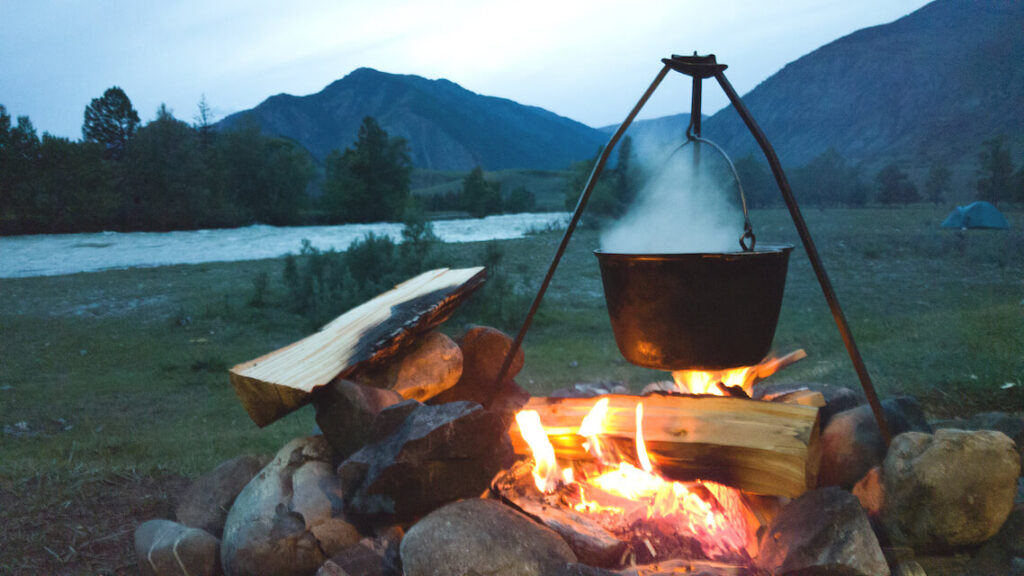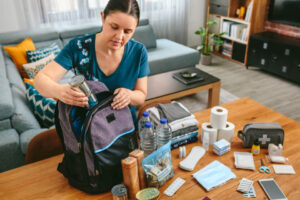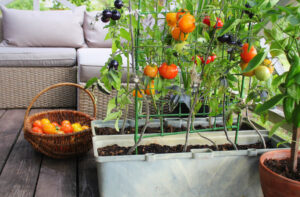
Whether you’re camping, bugging out, or have lost power, knowing how to cook outdoors is an essential skill to have. Nobody wants to be stuck eating cold beans straight out of the can, especially in a survival situation. Learn different methods for cooking outside and which tools you should keep on hand to make the process as easy as possible.
Cooking In The Outdoors: Why You Should Know How
There are a variety of situations where you might need to cook outdoors. You could be going on a fun family camping trip. Maybe you’ve lost power, and it won’t be back on for hours, despite your grumbling stomach. Or perhaps you’re in a survival situation and don’t have standard resources.
How to Cook Outside
How you cook in the great outdoors will depend on the situation. For example, if you’re backpacking, you’ll likely cook differently than if you’re camping in a car. There are options for everyone, from basic cooking over a fire to using solar ovens.
Whichever method you choose, make sure you have all of the necessary equipment and a plan before you pull out of the driveway. Ten miles into a backpacking trip or two days into a survival situation is not the time to realize that you don’t know how to use your stove! Always plan ahead.
Cook Over an Open Fire
Using an open fire to cook is a classic that dates back to our ancestors! Tap into your primal side with a campfire meal.
Cooking over an open fire is great because you can cook a large amount of food at once (hello, Dutch oven stews!). You can also use it for warmth on a chilly night, and it doesn’t rely on gas or other store-bought fuel. You can even start a fire on a wet winter day. One thing to consider with a fire is location. It requires outdoor space and can be challenging to handle if your wood store is limited or wet.
Remember to always manage fire responsibly, regardless of where you are or what the situation is. Keep it under control and thoroughly drown it when you’re ready to leave or go to bed. Otherwise, you could face a dangerous situation. It’s also vital to check the regulations around open flames in your area.
Build a Survival Cooking Stove
Building your own survival cooking stove won’t make for a luxury outdoor kitchen, but it can get you warm food quickly in a pinch. Warm food can help regulate your body temperature on a cold day and boost morale.
The simplest cooking stove is a tin can with each end cut off and vents punched along the top and bottom for airflow. This type of stove doesn’t require any store-bought fuel, and you can fill it with sticks, newspaper, or anything flammable that you have on hand. It has a small footprint and gets hot quickly – be sure not to touch the metal! The wood burns fast in such a small stove, so keep an eye on it and refill it when needed.
Cook With a Camp Stove
A single-burner gas or alcohol camp stove can be great if you want to boil water without building a fire. Camp stoves are great for making coffee and tea or dehydrated food like 4Patriots Emergency Food Kits and Survival Meals. They’re portable, lightweight, and easy to use, making them ideal for backpacking or your bug-out bag.
Double burner propane camp stoves can handle making foods more similar to what you’d make on your home stovetop. Larger stoves mean more options like cast iron pan pizzas, omelets, and more. Similar to backpacking stoves, though, the downside of gas and alcohol camp stoves is that they are reliant on fuel canisters.
If you’re looking for a wood-fired camp stove, check out the StarFire camp stove. It has the lightweight portability of a camp stove with the self-reliant benefits you get from cooking over a fire in a contained setting.
Cook With Solar Ovens or Earth Ovens
If you plan to be in one spot for a long time and live in an area with a lot of direct sunlight, then a solar oven can be a good investment that won’t take up much space in your bug-out kit. Think of it as an oversized solar blanket that directs the sun’s heat to your food!
Solar stoves are not as helpful if you don’t have much sunlight or time to stay in one place while cooking food. And, since they cook at a lower temperature (about 200°F), it’s crucial to ensure your food is cooked thoroughly.
Earth ovens are another option if you’re planning on staying in one spot for a long time, such as at home. No sunshine is required! An earth oven is a pit built into the ground and lined with stones. You use a fire to heat the stones, then the hot stones to cook your food. Like a solar stove, it’s easy to put together but cooks for several hours at a low temperature. Check the temperature and ensure your food is safe to eat.
Survival Cooking Gear to Have on Hand
When building your DIY outdoor cooking station, focus on four categories: something to cook on, things to cook with, fuel, and a way to clean up.
- A Way To Cook
What are you going to use for cooking? This category covers your camp stove, solar oven, earth oven, or plans for a campfire. Your stove is the foundation of your DIY outdoor grill station and the basis of the other three categories.
- Utensils
What are you going to use for cooking? You’ll need pots or pans, utensils, and bowls or plates. If you’re backpacking, you’ll want to invest in lightweight tools like bamboo sporks and collapsible dishes that don’t take up much space.
You can splurge on heavier and less space-efficient items like a cast iron pan for car camping. If you’re saving space in your bug-out bag, special-made backpacking tools can be a great purchase and even multipurpose. Make sure to pack enough gear for everyone in your group – no one wants to share forks!
- Fuel
You’ll need to plan fuel depending on which cooking method you pick. If you’re using a gas or alcohol stove, consider how many meals you plan to cook and use that number to judge how many canisters to bring. Factors like altitude and temperature can also affect how many you use.
If you’re planning to cook with a wood-burning fire of any kind, you’ll need, well, wood! For a car-camping trip, you may want to purchase firewood ahead of time. For backpacking, you will likely not want to carry a load of firewood to your campsite.
You will need a way to start your fire however you plan to use it. A lighter or matches and kindling are vital to have on hand in your camping kit or bug-out bag. Dryer lint in a sealed bag makes an excellent firestarter, but keep in mind that it burns fast!
- A Way to Clean Up
A small bottle of camp soap can be handy for washing your dishes, especially for multi-day trips. Not only are dirty dishes gross but they can also attract animals to your campsite. If you have room to spare, a bucket or plastic bin is an excellent addition to your kitchen kit. Otherwise, you can use one of the deeper pots or pans you brought along.
Build Your Bug-Out Bag With 4Patriots
Cooking outdoors has never been easier than with 4Patriots. Not only do we carry camp stoves and lighters to help you cook your food, but we also offer tasty, nutrient-rich survival food kits so you can enjoy delicious food for every meal. Shop online today to stock up on your camping or emergency kit.

